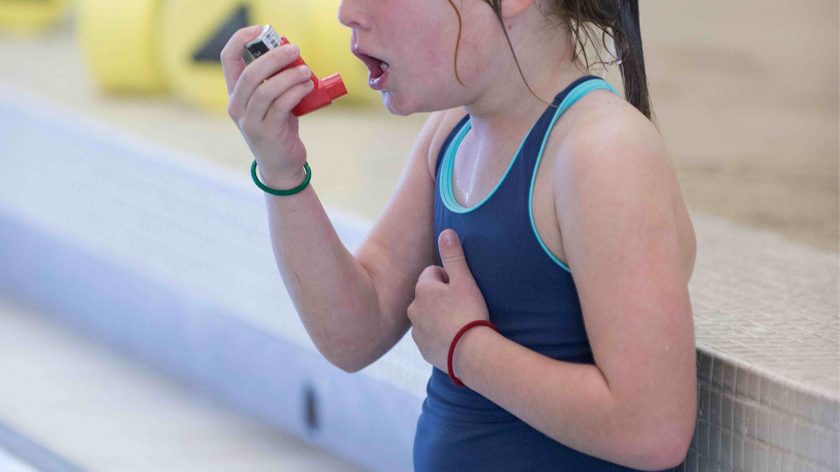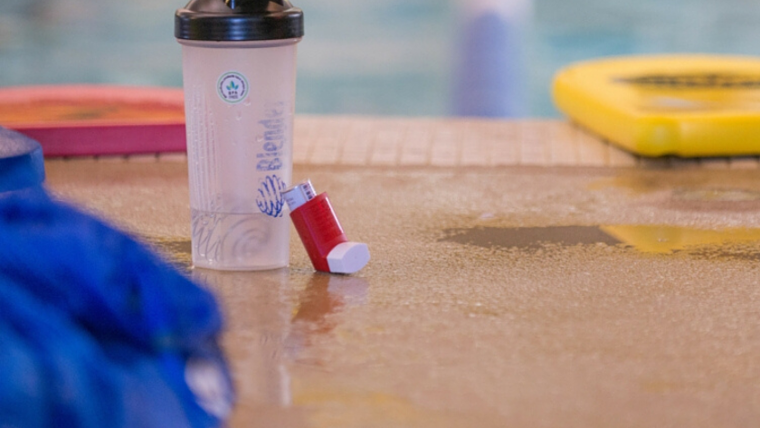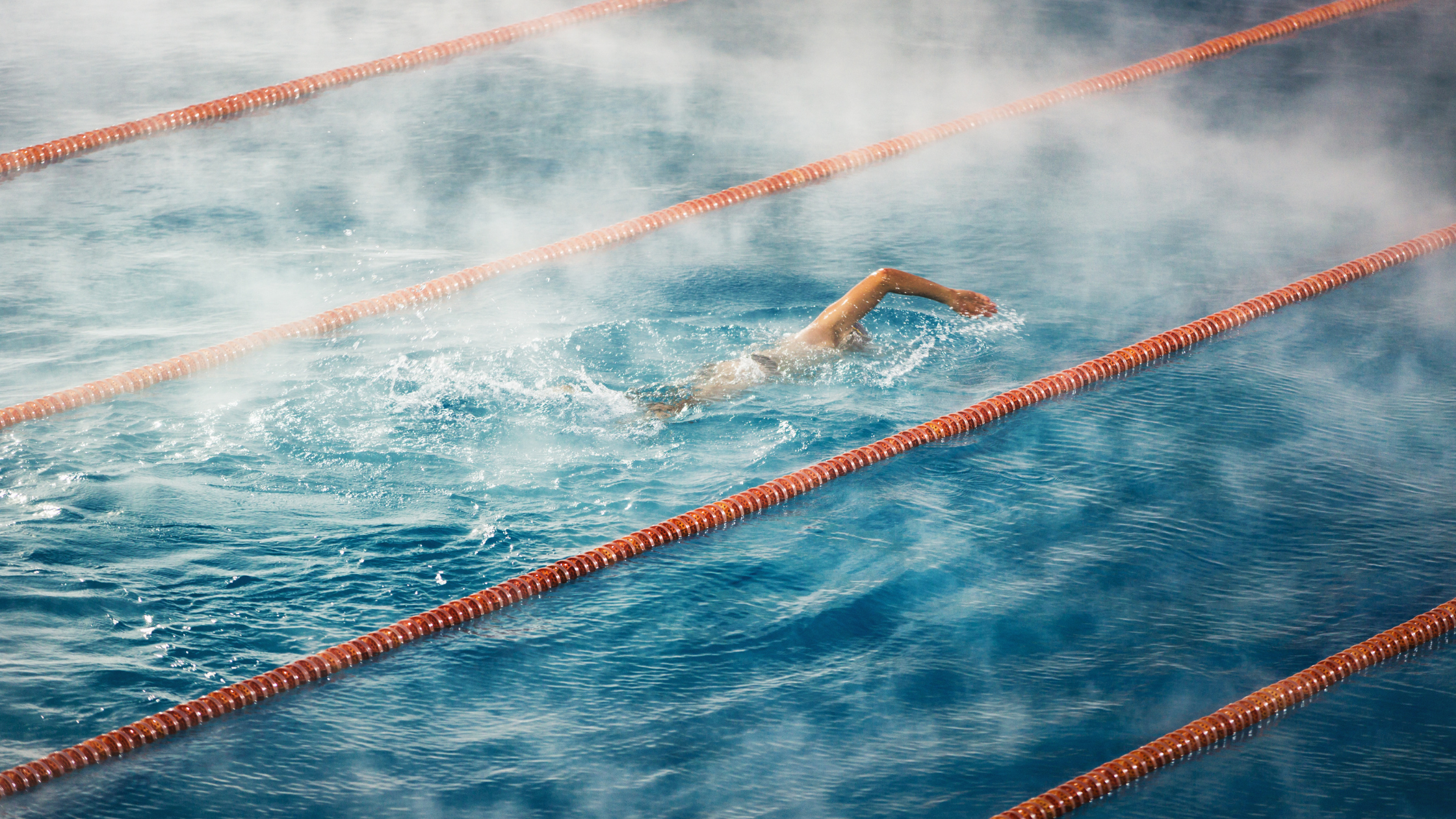What is Chloramine Poisoning?
Each and every year, reports come out of swimmers getting respiratory sickness from indoor swimming pools.1 This article will define what many people call "chloramine poisoning", and what can be done about it.
Covered in this article:
- Chlorine vs. Chloramine
- Chlorine
- Chloramine
- Chloramine poisoning
- Respiratory issues
- Ingestion
- Reducing the risk of chloramine poisoning
- Conclusion
Chlorine vs. Chloramine
First, we must distinguish between chlorine (the disinfectant) and chloramine (the disinfectant byproduct).
Related: Chloramine vs. Chlorine
Chlorine
Chlorine is the most commonly-used disinfectant on earth. It is certainly the most commonly-used residual disinfectant used in swimming pools, and is available in several different chlorine products. Fun fact: chlorine's active killing form, Hypochlorous Acid (HOCl), is naturally created in our bodies by our white blood cells to fight infections and other germs.2
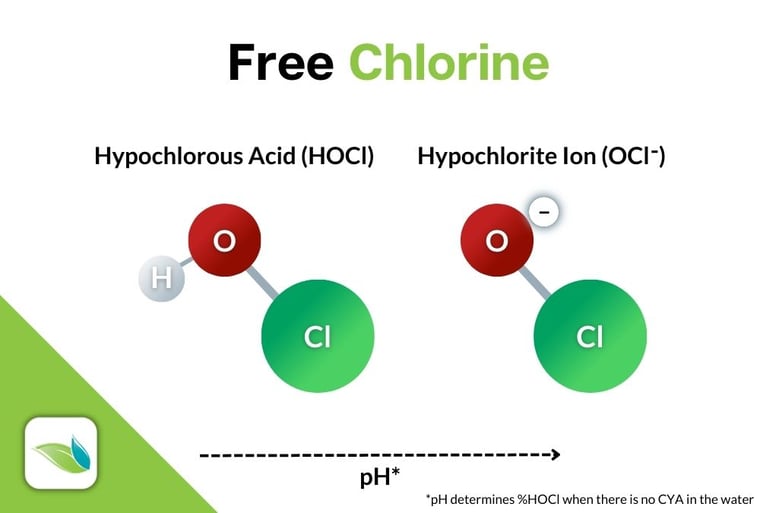
Elemental chlorine is a gas (Cl2), which has been banned in most states for swimming pool use. Chlorine gas is incredibly effective when diffused in water, but its dangers outweighed its benefits. Inhaling chlorine gas is toxic and can be lethal. So when you hear the term chlorine poisoning, it could be referring to inhaling chlorine gas. Usually, however, chlorine poisoning refers to injesting chlorine products, such as household cleaners.3 Disinfectant sprays that contain sodium hypochlorite, for instance, could accidentally be injested and that would be very bad. Call poison control and/or 911 immediately if that happens.
Chloramine
Chloramine is a broad term that means a disinfection byproduct (or, more technically, an oxidation byproduct) that is created when chlorine combines with nitrogen compounds. To get even more specific, chloramines are created when HOCl combines with inorganic ammonia (NH3).4
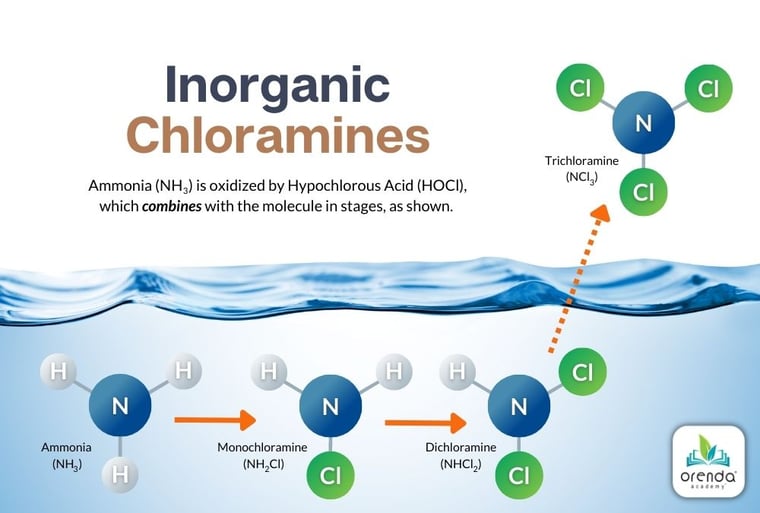
More broadly, we in the aquatics industry use the term chloramines to refer to any and all volatile disinfection byproducts created by chlorine attacking bather waste in water. Chloramines are not limited to just swimming pools, where everyone has the benefit of massive dilution in the body of water. More acute chloramine production can occur when simply mixing chlorine-based chemicals with ammonia-based chemicals. In natatoriums, this happens all the time when swimmers splash out chlorinated water onto the pool deck that was cleaned with an ammonia-based cleaner.5
Related: Pool Deck Cleaners and other Ammonia Sources
Chemical mixing of ammonia-based cleaners and chlorine-based cleaners most often happens accidentally at home. And it's easy to do. Take any name-brand household disinfectants and they likely offer both a sodium hypochlorite-based cleaner (chlorine), and also a dimethyl ammonium chloride-based (ammonia) cleaning product. If and when those products are mixed together, concentrated chloramine byproducts are offgassed and they are harmful.
So chloramine poisoning most often occurs at home when mixing cleaning products, such as in the bathroom or kitchen. But in our context, we hear it more often referring to swimmers, lifeguards and coaches getting sick from breathing chloramine-laden indoor swimming pool air.6
Chloramine poisoning
We have an entire page on this website with links to health studies about indoor air quality in natatoriums. Chloramine poisoning occurs when someone inhales (or ingests) chloramines or other volatile disinfection byproducts. It doesn't have to be just monochloramine, dichloramine or trichloramine. Chloramine pollution is a broad term to encompass other Volatile Organic Compounds (VOC's) like trihalomethanes (THM's), dichloromethylamine (CH3NCl2), cyanogen chloride (CNCl), and dichoroacetonitrile (CNCHCl2).7
Chlorine is usually the primary sanitizer and oxidizer in water, and it is usually the first to attack contaminants. The more complex the contaminant, the more byproducts (and the more harmful the byproducts). For instance, as discussed earlier, chloramines are technically byproducts of chlorine combining with inorganic ammonia (NH3). But most nitrogen compounds in water come from people, and are organic. That introduces more complexity, and therefore more variations of byproducts that can be more harmful.
Basic organic chemistry here: any time there is a carbon (C) and a chloride (Cl) in the same compound, it's most likely harmful to our health.
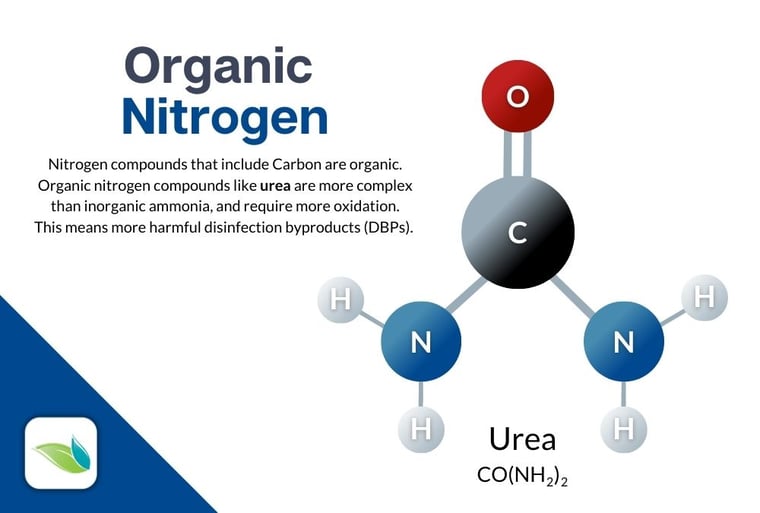
In other words, it takes more chlorine to destroy organic nitrogen compounds like urea. And because of urea's increased complexity, there are more byproducts produced as a result. And because urea is organic (meaning it contains Carbon), carbon and chloride together produce harmful byproducts.
Respiratory issues
The most common symptom of chloramine exposure is coughing during and after swimming. Sometimes the coughing lasts for hours after swim practice or competition. Other symptoms include eye, nose and throat irritation, itchy skin, and overall discomfort. But by far, the most urgent of these problems is upper respiratory distress. Prolonged exposure to chloramines is known to cause asthma, bronchitis and even permanent lung scarring; a condition called endemic granulomatous pneumonitis, aka lifeguard lung.8
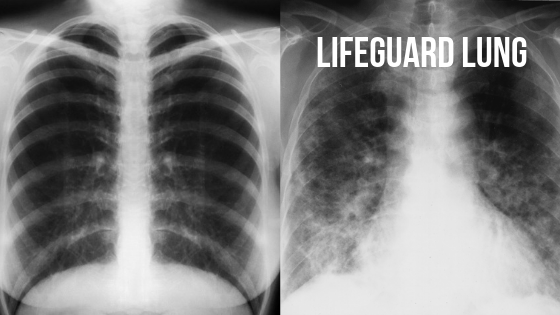
We speak from personal experience...indoor air quality problems are miserable.9
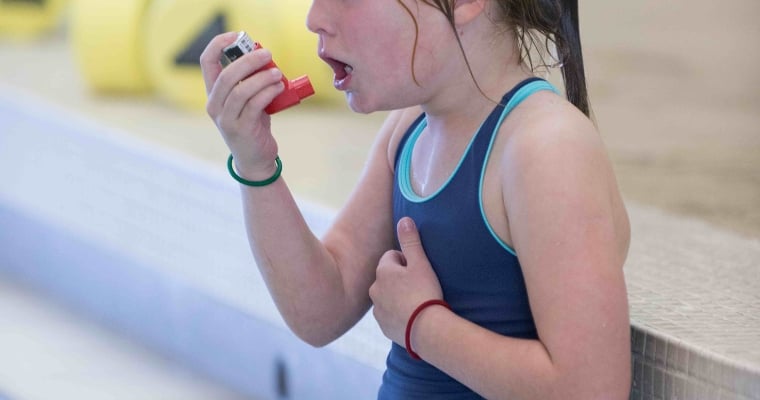
Ingestion
While some swimming pool water may get swallowed, it is unlikely to be enough to cause immediate sickness due to chloramines. There could be long-term health impacts, but the research on pool water ingestion is not as clear and established as the research on inhaling airborne pollutants. Frankly, we do not like the term chloramine poisoning to begin with, but until we know of a better term to describe getting sick from chloramines, it sticks.
Reducing the risk of chloramine poisoning
For swimmers, lifeguards, swim coaches, and anyone else that uses indoor pools, all indoor pool use comes with some risk. Chloramines and other byproducts are a necessary part of pool disinfection, and there's no way around it (that we know of). Thankfully, there are several ways to mitigate the risk of getting sick from indoor pool air.
Pool users can do their part to minimize contaminants they introduce to the water. The two main ones are: do not pee in the pool, and to shower before swimming. Basic hygeine goes a long way to improving air quality, especially if all swimmers do their part.
Pool operators have more options to improve indoor air. On the operations side, facility cleaning practices are paramount to having good indoor air quality. Avoid using any cleaning chemicals with ammonia or any other nitrogen compounds, and instead use either chlorine-based disinfectants or hydrogen peroxide.10 And this doesn't just mean the chemicals used around the pool itself...we recommend removing any and all ammonia cleaners from the facility. We see these chemicals often, and when removed, conditions improve in the facility every time.
On the water chemistry side, use of secondary systems like UV and Ozone are helpful. Use of residual chlorine supplements like enzymes are also helpful, though enzymes do not directly break down nitrogen. Enzymes instead break down carbon chains, which can simplify a complex organic compound, thereby reducing the amount of chlorine required to finish the job.
Pool facility owners/managers can do the most out of anyone. If the facility is struggling with air quality or water quality issues, the first step is diagnosing the problem with a facility evaluation. A natatorium study provides a detailed report of the root causes of the problems so they can be directly addressed, instead of just fighting symptoms while people get sick.
Related: What is a natatorium study?
If the study determines the natatorium is a fit for HVAC modifications, it would likely involve source-capture exhaust to capture the heavier-than-oxygen pollution and remove it from the facility.
Conclusion
Chloramine poisoning is a term most often associated with mixing household cleaning chemicals (bleach and ammonia) and breathing in the vapors. That would be considered acute exposure, whereas in indoor swimming pools, the same chemistry occurs on a much more diluted level. People in indoor pools experience prolonged chloramine exposure and lower levels. Neither one is good.
"Chloramine" is a broad term that includes any and all harmful byproducts of chlorination (volatile organic compounds (VOCs), disinfection byproducts (DBPs)) both in and out of the water. There are more of these compounds than we can list, but it's safe to assume none of them are healthy to breathe.
These problems are avoidable. New indoor pool facilities can be designed correctly from the beginning (we can help) to prevent chloramine buildup, and best practices at the facility can help mitigate the contamination getting into the water in the first place.
1 News reports like this one often leave out important details about what really happened. So we are left to make assumptions based on the most likely circumstances. In the case of the incident in August 2023, it sounds like standard chloramine pollution that reached a threshold where the indoor air quality (IAQ) became acutely hazardous for many. We know what that's like, having personally experienced such swim meets on numerous occasions.
2 Cleveland Clinic. (2021) What is Hypochlorous Acid? Health Essentials: Skin Care.
3 Normadin, B. (2017). Chlorine Poisoning. Healthline.com
4 US Centers for Disease Control. (last reviewed 2022). Chloramines and Pool Operation.
5 Most people forget to think about the chemicals used to clean the pool deck. The wet deck is often one of the largest sources of chloramine production in the natatorium. If the floor is cleaned with an ammonia-based cleaner (like dimethyl ammonium chloride), you can bet that concentrated chloramines will be created every time swimmers get in and out of the pool. In fact, swimmers feet will bring some of the ammonia in to the pool too, increasing measurable combined chlorine.
6 Weaver, W. A., Blatchley, E. R., 3rd, et.al. (2009). Volatile disinfection by-product analysis from chlorinated indoor swimming pools. Water research, 43(13), 3308–3318.
7 Li, J., & Blatchley, E. R., 3rd (2007). Volatile disinfection byproduct formation resulting from chlorination of organic-nitrogen precursors in swimming pools. Environmental science & technology, 41(19), 6732–6739.
8 Rose, C. S., Martyny, J. W., Newman, L. S., Milton, D. K., King, T. E., Jr, Beebe, J. L., McCammon, J. B., Hoffman, R. E., & Kreiss, K. (1998). "Lifeguard lung": endemic granulomatous pneumonitis in an indoor swimming pool. American journal of public health, 88(12), 1795–1800.
9 We speak from personal experience because our firm was founded by Eric Knight, a competitive swimmer (and former American Record Holder) who developed asthma and lifeguard lung from swimming indoors. Eric has permanent lung scarring as a result, and his experiences with bad indoor air quality are why Chloramine Consulting was created. Our firm exists to help eradicate these issues from as many indoor pools as possible so other swimmers do not have to be exposed to these problems, and live with the consequences for the rest of their lives like Eric does. If your pool has air quality challenges, the sooner you can get those issues evaluated and diagnosed, the sooner the problems can be solved.
10 Hydrogen peroxide (H2O2) is a powerful oxidizer and can disinfect surfaces effectively. That said, it neutralizes chlorine quickly: (Cl2 + H2O2 → O2 + 2HCl). Do not put hydrogen peroxide in a pool, because it would dechlorinate the pool. But cleaning bathroom floors and surfaces with it is fine. The main thing to avoid is using ammonia-based cleaning agents that will interact with chlorinated pool water to create more chloramines and other volatile DBPs.

 By
By
